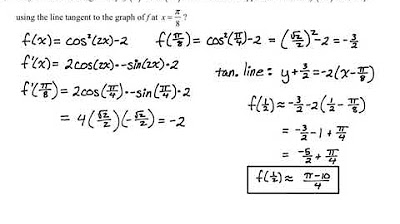Fall 2023 MNC: It's fundamental - Exploring FTC 1 & 2
TLDRIn this engaging session, the hosts delve into the fundamental theorem of calculus, exploring its critical role in the course. They discuss the first and second fundamental theorems, emphasizing the first's importance in understanding anti-derivatives of continuous functions. The session features a blend of theoretical explanation and practical demonstration using a graphing calculator (TI84) to visualize the concepts. The hosts also tackle a variety of problems involving piecewise functions and their derivatives, highlighting the application of the chain rule and the fundamental theorem of calculus in solving these problems. The discussion is rounded off with a reflection on the efficiency of the fundamental theorem in simplifying calculus computations and its frequent appearance in AP Calculus exams.
Takeaways
- 📚 The fundamental theorem of calculus was the main topic, emphasizing its importance in understanding calculus concepts.
- 🎥 The video featured a moderator absence and Allison's role in managing the chat.
- 📱 Tom demonstrated the use of a TI-84 calculator to visualize and understand the fundamental theorem of calculus.
- 🤔 The second fundamental theorem of calculus was discussed as a shortcut for calculating definite integrals without using Riemann sums.
- 📈 The first fundamental theorem of calculus was explained as being more important and foundational than the second.
- 🌟 The power of graphing calculators in visualizing and appreciating the significance of the fundamental theorem of calculus was highlighted.
- 📊 Tom showcased how to use the calculator for graphing piecewise functions and their derivatives, emphasizing the visual check against calculations.
- 🔍 The video script included a detailed walkthrough of solving calculus problems using the fundamental theorem and chain rule.
- 📝 The importance of including the endpoint intervals when determining increasing/decreasing intervals and concavity was noted.
- 🎯 The use of the candidate's test for finding absolute maximum and minimum values of a function was mentioned as a reliable method.
- 💡 The video script concluded with a reminder of the prevalence of fundamental theorem of calculus problems on AP Calculus exams and the benefits of using technology for problem-solving.
Q & A
What is the main topic of discussion in the transcript?
-The main topic of discussion in the transcript is the Fundamental Theorem of Calculus, particularly its application and importance in solving calculus problems.
What is the significance of the Fundamental Theorem of Calculus in the course?
-The Fundamental Theorem of Calculus is significant in the course as it is considered one of the most important concepts. It provides a shortcut for calculating definite integrals and is crucial for finding anti-derivatives of functions.
How does the use of a graphing calculator help in understanding the Fundamental Theorem of Calculus?
-The use of a graphing calculator helps in visualizing the relationships between functions and their derivatives, making it easier to appreciate the importance of the Fundamental Theorem of Calculus. It allows students to graph functions and their anti-derivatives, thus providing a visual check of the theorem's applications.
What is the first fundamental theorem of calculus?
-The first fundamental theorem of calculus states that if a function is continuous on a closed interval, then its integral over that interval is equal to the difference between the values of an antiderivative at the endpoints of the interval.
What is the second fundamental theorem of calculus?
-The second fundamental theorem of calculus states that the derivative of an indefinite integral (antiderivative) of a function is the original function itself.
How does the chain rule apply to the problems discussed in the transcript?
-The chain rule applies to the problems discussed in the transcript when dealing with functions that involve composite functions or when the upper bound of an integral is a function. It is used to find the derivative of the composite function by differentiating the outer function and then applying the derivative of the inner function.
What is the purpose of using piecewise functions in the problems?
-Piecewise functions are used in the problems to represent functions that have different expressions over different intervals. They are useful for solving calculus problems where the function's behavior changes at certain points, and they often appear in the AP Calculus exam in graphical form.
How does the concept of concavity relate to the fundamental theorem of calculus?
-The concept of concavity relates to the fundamental theorem of calculus in that the sign of the second derivative of a function can indicate whether the function's graph is concave up or concave down. This can be determined by analyzing the first derivative, which is found using the fundamental theorem of calculus.
What is the candidate's test mentioned in the transcript and how is it used?
-The candidate's test is a method used to find the absolute maximum and minimum values of a function on a closed interval. It involves finding the critical points of the function, evaluating the function at the critical points and the endpoints of the interval, and then selecting the maximum and minimum values.
What is the purpose of the exercises and problems discussed in the transcript?
-The purpose of the exercises and problems discussed in the transcript is to help students practice and understand the application of the fundamental theorem of calculus. These problems are designed to reinforce the concepts of anti-derivatives, concavity, and the use of technology in graphing and solving calculus problems.
Outlines
📚 Introduction to the Fundamental Theorem of Calculus
The video begins with an introduction to the topic of the Fundamental Theorem of Calculus, emphasizing its importance in the field of calculus. The moderator, Curtis Brown, is absent, but Allison is present to moderate the chat. The focus is on the first part of the theorem, which allows for the creation of an anti-derivative for any continuous function. The discussion includes the use of technology, specifically the TI-84 calculator, to better understand and visualize the theorem's applications.
📈 Graphing the Fundamental Theorem of Calculus
This paragraph delves into the practical application of the Fundamental Theorem of Calculus through graphing. The use of a graphing calculator is highlighted as a tool to appreciate the theorem's significance. A simple function, y = x^2, is used to demonstrate how the anti-derivative can be found and graphed. The process of graphing the derivative and the anti-derivative is explained, with a focus on visual confirmation of their relationship.
🔢 Exploring the Effects of Changing Lower Limit in Definite Integrals
The discussion continues with an exploration of how changing the lower limit in a definite integral affects the resulting function. The example of y = x^2 is extended to include different lower limits, illustrating how the anti-derivative changes with the limit. The concept of a vertical shift is introduced, and the impact on the graph is explained. The paragraph also touches on the use of different notations for definite integrals and the addition of precision values for faster graphing.
🎓 Applying the Fundamental Theorem of Calculus to Complex Functions
This section focuses on applying the Fundamental Theorem of Calculus to more complex functions, such as e to the power of negative x squared. The importance of the theorem in probability theory is mentioned, and the ability to graph anti-derivatives of continuous functions is emphasized. The discussion also includes the use of technology to graph these functions and validate the theorem's applications.
📊 Solving Problems Involving the Fundamental Theorem of Calculus
The paragraph presents a problem-solving approach to the Fundamental Theorem of Calculus, focusing on a piecewise-defined function. The process of finding intervals of increase and decrease, as well as absolute maximum and minimum values, is detailed. The paragraph emphasizes the importance of stating the theorem when solving problems and the use of the candidate's test for finding critical points and extrema.
🖋️ Analyzing Concavity and Sketching Graphs
The focus shifts to analyzing concavity and sketching graphs of functions derived from the Fundamental Theorem of Calculus. The process of determining concave up and down intervals is explained, using the derivative of the function. The paragraph also discusses the value of sketching graphs to understand the relationship between a function and its derivative, and how this can serve as a check for computational accuracy.
📈 Graphing Piecewise Functions and Derivatives
This section demonstrates how to graph piecewise functions and their derivatives using technology. The process of entering piecewise functions on a graphing calculator is outlined, and the graph of a specific function is produced and analyzed. The paragraph also includes a discussion on the use of technology to check work and the importance of understanding the underlying calculus concepts.
🤔 Reflecting on the Fundamental Theorem of Calculus
The video concludes with a reflection on the power of the Fundamental Theorem of Calculus and its applications in problem-solving. The discussion includes the variety of problems that can be solved using the theorem, the importance of understanding chain rules and derivatives, and the预告 of upcoming topics and dates for future sessions.
Mindmap
Keywords
💡Fundamental Theorem of Calculus
💡Derivative
💡Antiderivative
💡Definite Integral
💡Graphing Calculator
💡Chain Rule
💡Critical Points
💡Concavity
💡Piecewise Function
💡Area Arguments
Highlights
Introduction to the fundamental theorem of calculus and its importance in the course.
Discussion on the common misconceptions about the fundamental theorem of calculus and its two parts.
Use of technology, specifically the TI-84 calculator, to better understand and visualize calculus concepts.
Explanation of how to use the TI-84 calculator for graphing and understanding the fundamental theorem of calculus.
Demonstration of the first fundamental theorem of calculus using a simple function and the calculator.
Visual comparison of the original function and its antiderivative using the calculator's graphing capabilities.
Discussion on the importance of the fundamental theorem of calculus in creating antiderivatives for any continuous function.
Explanation of how to change the lower limit of integration and its effect on the antiderivative function.
Demonstration of graphing the antiderivative function with different lower limits and the impact on the graph.
Introduction to the concept of concavity and how it relates to the fundamental theorem of calculus.
Use of the candidate's test for finding absolute maximum and minimum values of a function on a closed interval.
Illustration of how to find the intervals of increase and decrease for a function defined by a definite integral.
Discussion on the practical applications of the fundamental theorem of calculus in solving problems on the AP Calculus exam.
Explanation of how to find the derivative of a function defined as a definite integral with respect to a variable upper bound using the chain rule.
Demonstration of the power of using technology to check calculations and visualize calculus problems.
Conclusion and summary of the key points discussed during the session on the fundamental theorem of calculus.
Transcripts
Browse More Related Video

It All Adds Up: Accumulation Problems

2022 Live Review 5 | AP Calculus AB | Focusing on the Big Theorems Including IVT, EVT, & MVT

2022 Live Review 3 | AP Calculus BC | Taylor Polynomials

Fall 2023 MNC: Slice thin and add - Riemann sums and definite integrals

5 | MCQ | Practice Sessions | AP Calculus AB

AP Calc AB & BC Practice MC Review Problems #4
5.0 / 5 (0 votes)
Thanks for rating: